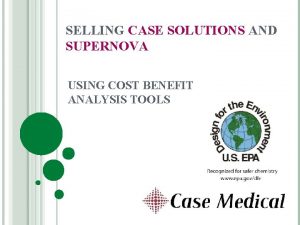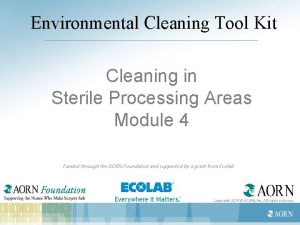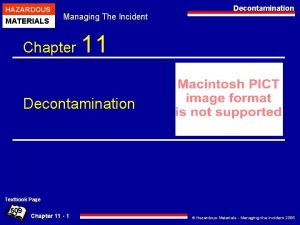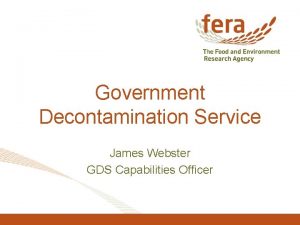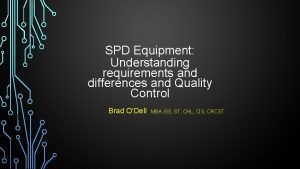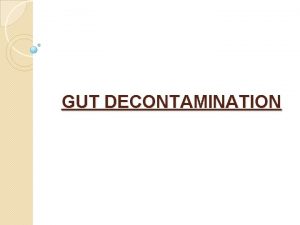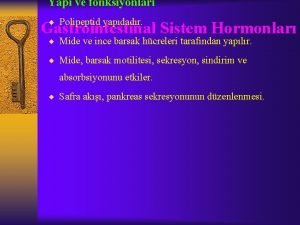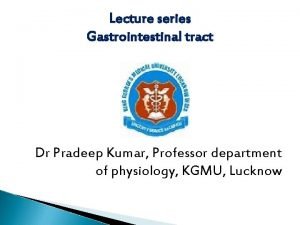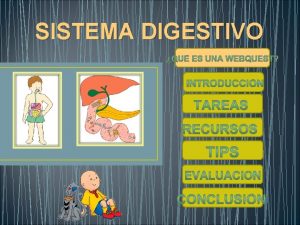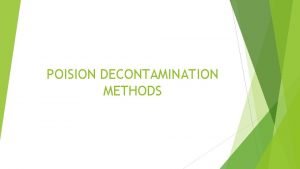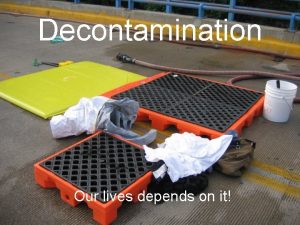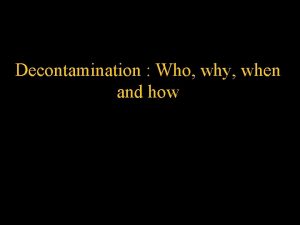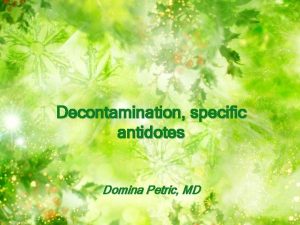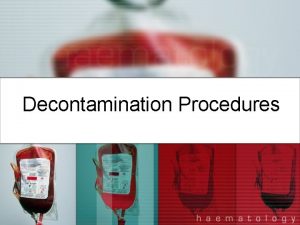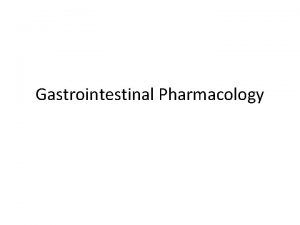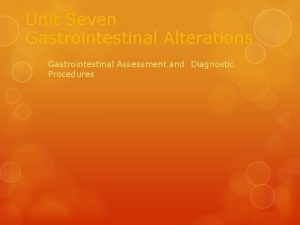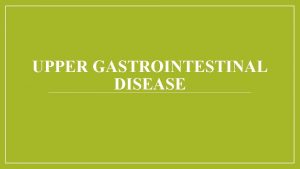POISION DECONTAMINATION METHODS GASTROINTESTINAL DECONTAMINATION The decision to












- Slides: 12

POISION DECONTAMINATION METHODS

GASTROINTESTINAL DECONTAMINATION The decision to perform GI decontamination should be based upon; The specific poison(s) ingested. Time from ingestion to presentation. Presenting symptoms Predicted severity of poisoning

Decontamination Methods Various methods of GI decontamination, which can be used alone or in combination, include 1. Oral adsorbents (Activated Charcoal). 2. Gastric lavage. 3. Emesis (Syrup Ipecac). 4. Whole bowel irrigation. 5. Catharsis. 6. Endoscopic removal / surgery. 7. Dilution. 8. Miscellaneous Adsorbents.

1. ACTIVATED CHARCOAL Activated charcoal has emerged over the past decade as the preferred means of GI decontamination. Activated charcoal is an insoluble, non-absorbable, inert, fine carbon powder produced by the pyrolysis of organic material and then treated with steam and acid. Activated charcoal has an extensive network of interconnecting pores that are capable of binding (adsorbing) and trapping chemicals within minutes of contact, thus preventing their absorption and toxicity.

Activated charcoals in current use have a binding surface area of 950 to 2000 m 2 per gram and can adsorb between a few mg and 1 g of intoxicant per gram of activated charcoal. The amount of drug bound by charcoal is dependent upon: The characteristics of the ingested drug; Small, highly ionized chemicals such as metals, electrolytes, acids, and alkali are not well absorbed by activated charcoal The surface area of the specific activated charcoal preparation employed The relative amounts of activated charcoal and the intoxicant

DOSE: The recommended dose of activated charcoal is 1 g/kg with at least a 10: 1 ratio by weight of activated charcoal to intoxicant the usual single adult dose is 25 to 100 g mixed with water and administered as slurry by mouth or nasogastric tube. Doses larger than 100 g are not recommended in obtunded patients due to an increased risk of vomiting and aspiration. The commercial product should be vigorously agitated prior to administration to re-suspend all activated charcoal.

EFFICACY: As with other forms of GI decontamination, activated charcoal efficacy is greatest when administered within one hour from ingestion. Activated charcoal appears superior to syrup of ipecac or gastric lavage for preventing the absorption of ingested intoxicants. Gastric lavage followed by or preceded and followed by activated charcoal may be more effective than activated charcoal alone at preventing drug absorption.

INDICATIONS: Activated charcoal is commonly the only GI decontamination measure needed to treat an overdose and should be administered even when the poison exposure history is equivocal. The greatest benefit of activated charcoal is seen when it is administered within one hour of ingestion, but its administration is recommended for all poison ingestions, unless the ingested agent is clearly nontoxic or not bound by activated charcoal.

CONTRAINDICATIONS: Activated charcoal is absolutely contraindicated in patients with; Bowel obstruction or perforation. A patient with a depressed level of consciousness until the airway is secured by endotracheal intubation Activated charcoal administration is not recommended in patients who have ingested non-adsorbable acidic or alkaline corrosives and who require Endoscopy because charcoal will obstruct the view of the endoscopist It is also not recommended for patients who have ingested low-viscosity hydrocarbons and who are at high risk for aspiration unless a lethal absorbable agent has been coingested

COMPLICATIONS: Serious adverse effects from single-dose activated charcoal are rare. Common side effects include nausea, vomiting, abdominal cramps, and diarrhea, particularly when the drug is used with sorbitol. Constipation and mechanical bowel obstruction may occur in patients receiving repeated doses with an aqueous base. Aspiration of activated charcoal with gastric contents may result in pneumonitis or, rarely, bronchiolitis obliterans and airway obstruction.

DRUGS THAT ACTIVATED CHARCOAL IS EFFECTIVE IN ADSORBING: Activated charcoal has been shown to be effective in adsorbing the following drugs: Acetaminophen. Tricyclic antidepressants Antipyrines. Arsenic Aspirin Atropine antihistamines Chlorpheniramine and related Dextro-amphetamine Digoxin Isoniazid. Salicylates & Morphine Phenytoin Quinidine Phenobarbitone and other barbiturates Quinine.

DRUGS THAT ACTIVATED CHARCOAL IS NOT EFFECTIVE IN ADSORBING: Activated charcoal has not been shown to be effective in adsorbing the following: Acids and caustic alkalis Aromatic alcohols Boric acid Ethylene glycol Heavy metals. • Iron • Lithium Malathion Methylcarbamate Methanol
 Objectives of decision making
Objectives of decision making Slidetodoc.com
Slidetodoc.com Steris decontamination sinks
Steris decontamination sinks Sterile processing decontamination ppe
Sterile processing decontamination ppe Contamination vs cross contamination
Contamination vs cross contamination Government decontamination service
Government decontamination service Steelco decontamination equipment
Steelco decontamination equipment Sphair decontamination
Sphair decontamination Ewald tube
Ewald tube Sekretin ailesi
Sekretin ailesi Gastrointestinal structure
Gastrointestinal structure Embriologia del sistema gastrointestinal
Embriologia del sistema gastrointestinal Digestive system diagram
Digestive system diagram


